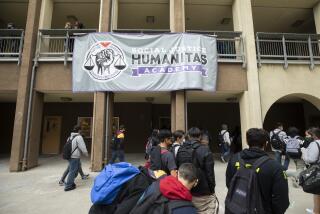‘New Math’ Adds Up to O.C. Debate
- Share via
Eileen Spatz of San Clemente remembers attending grade school in Fullerton, when math classes stressed rote memorization of multiplication tables and homework was plentiful. Counting on fingers was forbidden.
“I’m not going to say it was the good old days, because it wasn’t fun. But we learned,” said Spatz, now the mother of two school-age children who have been taught the so-called “new math.”
Next month, when thousands of Orange County youngsters return to class, Spatz will be steering her children to a private school for the first time because she no longer has confidence in public schools.
Spatz said math lessons at her daughter’s school included little homework and encouraged use of fingers, an abacus and even a calculator. Then she said she found out her son, soon to be a third-grader, often was given a choice between math and art projects.
“What are we paying taxes for?,” Spatz said recently. “What kid is going to choose to do math instead of cut-and-paste? My daughter is subtracting on her fingers.”
Back to Basics
Spatz isn’t a lone critic. She’s joined by outraged legislators and math and reading experts. And their back-to-basics refrain underscores one of the most controversial issues in education today: how best to provide children with the basic math and reading skills they will need to negotiate an increasingly complex world.
The state Department of Education is paying attention. Earlier this year, the department revamped its guidelines for teaching reading to emphasize phonics--a technique that teaches children to tackle new words by sounding out the letters.
Earlier this month, the department met to discuss math education, a subject that has been tinkered with for generations.
“Discussions about what’s best have been going on forever,” says Rosemary Herendeen, director of staff development and curriculum at La Habra City School District. “Teachers are always in the middle. And the pendulum swings too far one way before it comes back and swings the other way.”
The debate is all the more difficult because both sides agree that the opposing view has something to offer.
Backers of “progressive” math support techniques such as group learning, where teachers step back and encourage schoolchildren to help each other grapple for the correct answer. Lecturing goes nowhere, they say.
Students also benefit from pondering math problems and providing oral or written explanations for their solutions, say supporters.
“Of course the correct answer is important,” said Richard Doty, math chairman in the Santa Ana Unified School District, which is taking part in a new math experiment. “But if you have a problem with 20 steps, and the student goofed on the last part, wouldn’t you be heartened if 19 out of 20 of those steps were done correctly? This all needs to stay in context.”
But the critics seem to be winning the debate and are hoping the state will take a strong stance in opposition to group learning and other controversial techniques.
That may sound like exactly what Spatz and others are demanding. But changing teaching guidelines is a byzantine process that is likely to take at least two years before actual changes trickle down from the state to the county’s Board of Education, to the local school district, to the individual school, to the teacher at the front of the class.
“By that time you’ve lost a generation that can’t read, can’t write and can’t add,” fumes Orange County Assemblyman Dick Ackerman (R-Fullerton), a member of the Assembly Education Committee and a supporter of a back-to-basics approach. “The answer to two plus two is four, it’s not five. And it doesn’t matter what your peer group thinks.”
Dismal test scores fuel the debate. In the last national math exam in 1992, only Louisiana and Mississippi ranked below California.
The Local Picture
Locally, the picture is not nearly as bad. Nor is it heartening, educators say.
Results released last year from the California Learning Assessment System tests show just over 50% of eighth-grade students in Orange County had at least “basic” reading and writing skills, while just 34% had basic understanding of math.
“I’m concerned that education is in a dumbing-down process; it’s a joke now,” said Robert Stewart, an English teacher with the Anaheim Union High School District who has taught for nearly 30 years. “They keep trying to reinvent the wheel when it was all right to begin with.”
Professor Robert Marcucci, a math education professor at San Francisco State University, says he only needs to look into his classroom to see what a poor job public schools are doing. Theoretically, his college students--many of whom hope to teach--should be among the public school system’s brightest.
“But I’m seeing students who are weaker than they’ve ever been in the past,” Marcucci said. A large percentage of freshmen need remedial help in math or reading skills, he said. “There is a big problem. . . . It’s pretty scary.”
Nearly a decade ago, the buzzword in education was change. The state Department of Education, which establishes statewide teaching guidelines, backed new methods of teaching intended to boost math and reading comprehension.
In math, that meant encouraging children to work in groups, using tiles, building blocks and other tools to visually illustrate mathematical methods. In reading, that meant emphasizing the whole language approach that teaches children to read in part by memorizing entire words, often in the context of a story or fairy tale.
Weighing Approaches
Opponents say that while some elements of the new approaches are beneficial, the shift went too far.
“There needs to be a good mixture of basic skills, conceptual understanding and problem solving,” said Michael McKeown, a founder of a Southern California group called Mathematically Correct, which keeps in touch with members nationwide via the Internet.
Anything else leaves a child’s education lacking, said McKeown, whose group is concerned that too many math classes in California skirt the basics.
Some educators say such concerns are unfounded. They blame the media and critics for fostering the belief that state guidelines have rejected proven methods. That is simply untrue, said Julie Chan, English language coordinator for the Orange County Board of Education.
“The framework just mentioned new items, and it was misinterpreted as saying that the rest was unimportant or wouldn’t be taught,” Chan said. “Parents say, ‘I want to make sure my kids are getting phonics.’ Well, I don’t know how you could teach reading without phonics.”
Barbara Smith, an administrator in the Capistrano Unified School District where Spatz’s children attended school, says she also must confront misconceptions about her district abandoning phonics or pushing watered-down math.
“That just doesn’t happen here, we strike a balance,” Smith said in response to Spatz’s complaints. “There are two extremes here, and we find ourselves somewhere in the middle.”
Some schools are still trying experiments to marry the old and the new.
Spurgeon Intermediate School in Santa Ana, for example, is taking part in a nationwide math experiment called QUASAR, Quantitative Understanding: Amplifying Student Achievement and Reasoning.
The project, based at the University of Pittsburgh, tries to make math relevant to youngsters. For example, it teaches children how to figure the cost of supermarket goods by weight, and illustrates geometry by building a town’s homes and businesses out of construction paper.
Spurgeon Intermediate, located in one of the most impoverished areas in the county, has posted modest gains, QUASAR backers say.
Dr. Wayne Bishop, a math professor at Cal State Los Angeles, says he is skeptical of math programs like QUASAR that claim to show improvements.
“I’ve been following these things for years, being somewhat cynical, and I just don’t believe it,” said Bishop, who abruptly quit a state math revision task force last year because he felt it did not go far enough to ensure basic math knowledge. “There’s no indication that the current movement has proven the mathematical opportunities.”
But Doty, who is coordinating the program at Spurgeon, said that on districtwide tests, the school has gone from dead last to ranking in the middle. Doty takes that as a sign the program is working. And he says he has no intention of changing, regardless of any new state guidelines.
“I’m concerned that the backlash from uninformed parties is going to have a negative impact on the positive influence this has had,” said Doty.
Frustrated Parents
Disputes like this frighten parents who are ill-equipped to figure out which teaching methods are best for their children.
Susan Krumpetich of Laguna Hills confronted the debate in 1993, when she began questioning the lack of homework being sent home with her fourth-grade daughter. Division also seemed to be getting little attention.
The final straw, she says, was when her daughter told her she couldn’t ask the teacher a math question unless the fellow students in her math group failed to first come up with the answer. That’s when Krumpetich found herself wondering whether her daughter was getting a proper education.
Krumpetich has since joined an association for teachers, not because she is an educator, but because it will help her keep better track of teaching trends. She stresses that she blames the state instructional framework--not the teachers in the trenches--for not putting enough emphasis on the basics.
“I just have no confidence in it [the new system]. I didn’t see her progressing the way I thought she should,” said Krumpetich. She has since placed her daughter in a private after-school math tutoring program and reports that she is doing well. “But I shouldn’t have to do that. The schools should be teaching her what she needs to know. That’s what they’re there for.”
(BEGIN TEXT OF INFOBOX / INFOGRAPHIC)
Plus and Minus
Math instruction guidelines for public schools are being revamped, in part because of complaints that different approaches ignore the basics. Here are two approaches to the simple multiplication problem, 12 x 4:
* The current approach is bare bones, requiring students to have memorized multiplication tables to get the correct answer: 48.
* The “new math” method encourages students to conceptualize the multiplication process by laying out four rows of 12 tiles or blocks and then adding them.
****
WHAT THEY SAY
* New-math critics: Too much time is spent fiddling with objects instead of hammering basics, such as multiplication tables.
* New-math backers: Approach achieves the goal of helping students understand theory behind multiplication--not just how to do it; encourages students to interact with each other.
Source: Times reports
More to Read
Sign up for Essential California
The most important California stories and recommendations in your inbox every morning.
You may occasionally receive promotional content from the Los Angeles Times.











